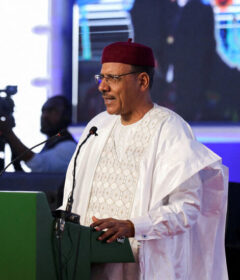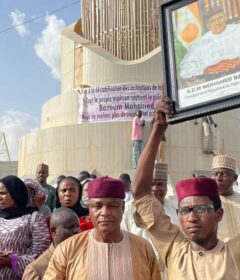Ethiopia profile
A chronology of key events:
2nd century AD – Kingdom of Axum becomes a regional trading power.
4th century – Christianity becomes state religion.
King Ezana’s Stele: One of the 1700-year old obelisks erected by the Kingdom of Axum
Ethiopia unveils ancient obelisk
1530-31 – Muslim leader Ahmad Gran conquers much of Ethiopia.
1818-68 – Lij Kasa conquers Amhara, Gojjam, Tigray and Shoa.
1855 – Kasa becomes Emperor Tewodros II.
1868 – Tewodros defeated by a British expeditionary force and commits suicide to avoid capture.
1872 – Tigrayan chieftain becomes Yohannes IV.
1889 – Yohannes IV killed while fighting Mahdist forces and is succeeded by the king of Shoa, who becomes Emperor Menelik II.
1889 – Menelik signs a bilateral friendship treaty with Italy at Wuchale which Italy interprets as giving it a protectorate over Ethiopia. Ethiopia rejects this interpretation, later renounces the treaty and repays a loan.
1889 – Addis Ababa becomes Ethiopia’s capital.
Italy invades
1895 – Italy invades Ethiopia.
1896 – Italian forces defeated by the Ethiopians at Adwa. Treaty of Wuchale annulled, and Italy recognises Ethiopia’s independence but retains control over Eritrea.
Haile Selassie
Emperor of Ethiopia and god to the Rastafarian movement.
1913 – Menelik dies and is succeeded by his grandson, Lij Iyasu.
1916 – Lij Iyasu deposed and is succeeded by Menelik’s daughter, Zawditu, who rules through a regent, Ras Tafari Makonnen.
1930 – Zawditu dies and is succeeded by Ras Tafari Makonnen, who becomes Emperor Haile Selassie I.
1935 – Italy invades Ethiopia.
1936 – Italians capture Addis Ababa, Haile Selassie flees. Ethiopia combined with Eritrea and Italian Somaliland to become Italian East Africa.
Haile Selassie’s reign
1941 – British and Commonwealth troops aided by the Ethiopian resistance defeat the Italians, and restore Haile Selassie.
1952 – United Nations federates Eritrea with Ethiopia.
1962 – Haile Selassie annexes Eritrea, which becomes an Ethiopian province.
1963 – First conference of the Organisation of African Unity held in Addis Ababa.
“Red Terror”
1973-74 – An estimated 200,000 people die in Wallo province as a result of famine.
Haile Mengistu
Haile Mengistu (on right): Thousands were killed under Marxist dictator’s “Red Terror”
Red Terror ‘hard to forgive’
1974 – Haile Selassie overthrown in military coup. General Teferi Benti becomes head of state.
1975 – Haile Selassie dies in mysterious circumstances while in custody.
1977 – Benti killed and replaced by Colonel Mengistu Haile Mariam.
1977-79 – Thousands of government opponents die in “Red Terror” orchestrated by Mengistu; collectivisation of agriculture begins; Tigrayan People’s Liberation Front launches war for regional autonomy.
1977 – Somalia invades Ethiopia’s Ogaden region.
1978 – Somali forces defeated with massive help from the Soviet Union and Cuba.
1984-85 – Worst famine in a decade strikes; Western food aid sent; thousands forcibly resettled from Eritrea and Tigre.
1987 – Mengistu elected president under a new constitution.
1988 – Ethiopia and Somalia sign a peace treaty.
After Mengistu
1991 – Ethiopian People’s Revolutionary Democratic Front captures Addis Ababa, forcing Mengistu to flee the country; Eritrea establishes its own provisional government pending a referendum on independence.
1992 – Haile Selassie’s remains discovered under a palace toilet, and reburied in Addis Ababa’s Trinity Cathedral in 2000.
1993 – Eritrea becomes independent following referendum.
1994 – New constitution divides Ethiopia into ethnically-based regions.
1995 – Meles Zenawi assumes post of prime minister.
War with Eritrea
1999 – Ethiopian-Eritrean border clashes turn into a full-scale war.
2000 – Eritrea, Ethiopia sign a peace accord which envisage troop withdrawals and UN peacekeepers. A boundary commission is given the task of defining the border; it awards Badme to Eritrea, but Ethiopia’s continued occupation of the town is a major source of friction.
2004 January-February – Nearly 200 killed in ethnic clashes in isolated western region of Gambella. Tens of thousands flee area.
2004 March – Start of resettlement programme to move more than two million people away from parched, over-worked highlands.
2005 March – US-based Human Rights Watch accuses army of “widespread murder, rape and torture” against Gambella region’s ethnic Anuak people. Military rejects charge.
2005 April – First section of Axum obelisk, looted by Italy in 1937, is returned to Ethiopia from Rome.
Disputed poll
2005 May – Disputed multi-party elections lead to violent protests over months.
2005 August-September – Election re-runs in more than 30 seats: Officials say the ruling party gains enough seats to form a government.
2005 December – International commission, based in The Hague, rules that Eritrea broke international law when it attacked Ethiopia in 1998.
More than 80 people, including journalists and many opposition leaders, are charged with treason and genocide over November’s deadly clashes.
Somalia tensions
2006 November – Ethiopian troops enter Somalia, engage in fierce fighting with Islamists controlling large parts of the country and capital. The Islamists disperse.
2006 December – Exiled former dictator Mengistu Haile Mariam is convicted, in absentia, of genocide at the end of a 12-year trial. He is later sentenced to death.
2008 July – UN Security Council votes unanimously to end UN peacekeeping mission monitoring disputed border between Ethiopia and Eritrea.
2008 September – Celebrations held to mark completion of reassembly of 1700-year-old Axum Obelisk, looted in 1937 during the Italian conquest and returned by Italy in three parts after 2005.
2008 December – Police re-arrest key opposition leader Birtukan Medeksa, who was jailed for her role in the opposition protests after the 2005 polls, and freed under a government pardon in 2007.
2009 June – Ethiopia admits to “reconnaissance missions” in Somalia despite formal withdrawal of troops in January, but denies re-deploying troops.
2009 December – Rebels of the Ogaden National Liberation Front claim capture of several towns in the east in a month of heavy fighting.
2010 May – Ruling Ethiopian People’s Revolutionary Democratic Front (EPRDF) wins huge majority in parliamentary elections, handing Prime Minister Meles Zenawi a fourth term. International observers highlight shortcomings.
Zenawi era
A former rebel leader against the military regime, Meles Zenawi dominated Ethiopian political life from 1995 to his death in 2012
2012 August – Prime Minister Meles Zenawi dies. Succeeded by Foreign Minister Hailemariam Desalegn in September.
2015 May – Ruling EPRDF scores another victory in general election widely criticised by the opposition.
2016 October – Government declares state of emergency following months of violent anti-government protests.
2018 February – As anti-government protests continue, Prime Minister Desalegn resigns.
Abiy reforms
2018 April – Abiy Ahmed, an ethnic Oromo, wins over his challengers to become leader of the ruling EPRDF and therefore prime minister. He launches a comprehensive programme of political reform at home and diplomatic bridge-building abroad.
2018 May-June – Government releases thousands of political prisoners, and lifts state of emergency.
2018 July – Ethiopia and Eritrea declare their war is over as Ethiopia agrees to evacuate disputed territory.
2018 October – The government signs a peace deal with the separatist Ogaden National Liberation Front (ONLF), ending a 34-year armed rebellion.
Parliament elects Sahle-Work Zewde as Ethiopia’s first woman president, and first female head of state since Empress Zawditu (1928-1930).
2019 March – Ethiopian Airlines plane crashes southeast of Addis Ababa, killing all 157 people on board, leading to grounding of Boeing 737 Max 8 planes around the world.
2019 June – Army chief Seare Mekonnen and Amhara State Governor Ambachew Mekonnen killed while putting down coup attempt against the federal government.
Source: Read Full Article


